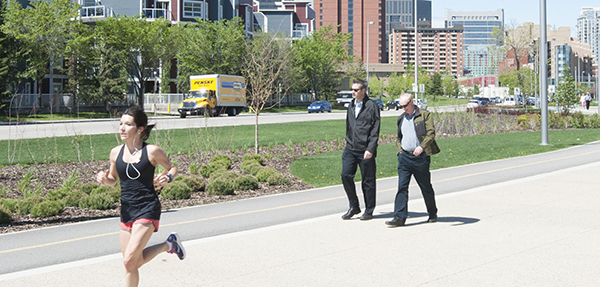
March 11, 2016 | Shelley Boettcher
Design heavy
Local researchers applaud study that links urban design to obesity ratesAre you overweight and out of shape? It could be because of where you live.
Local researchers are pointing to a new international study that has found a connection between obesity and urban geography – in particular as it relates to living in high-rise apartments.
"The literature out there is pretty clear — there's a strong relationship between the walkability of your environment and your health," said Calgary architect John Brown, a professor in the Faculty of Environmental Design at the University of Calgary.
The study, published last December in the medical journal BMJOpen, followed 6,000 residents in Lausanne, Switzerland for more than a decade.
From 2003-06, the team weighed each volunteer at the beginning of the study, and determined each participant's body mass index.
Volunteers also gave their addresses, as well as personal information, including gender, age, ethnicity, physical activity, alcohol consumption, education level and if they smoked.
Then, from 2009-12, roughly 4,500 participants returned for a second weigh-in.
When the team mapped the results, they found Lausanne neighbourhoods had either a high or a low body mass index — not both. In other words, most people were similar to others in their neighbourhood; they either mostly had normal weights or were overweight.
Weight gain and weight loss were also typically bunched together in the same way.
"It's possible you behave like your neighbors, and it's possible the fact that you arrive in a building where your neighbours are obese is a danger for you, and it's more likely for you to become obese," said Stéphane Joost, the study's lead author and an expert on public health cartography at the École Polytechnique Fédérale de Lausanne.
Researchers concluded that the city's design was to blame for concentrated obesity rates – in particular, clusters of apartment towers that, despite being within eyeshot of a nearby lake, were isolated by parking lots and highways.
Brown said the Swiss team's findings have universal applications – especially here in Calgary.
"If you have to walk where there is no sidewalk, or it doesn't feel safe from traffic or other nefarious things, it doesn't matter how beautiful the park is. You won't go," he said.
"And if you do go, you'll drive there. Nobody wants to walk through a parking lot or along a busy road."
Calgary fitness trainer Pete "The Fitness Guy" Estabrooks argues our personal choices are what make us fit or flabby – where we live is only part of the equation.
"An apartment can't make you fat. A car can't make you fat. Your phone can't make you fat," said Estabrooks.
"But text the Uber guy to bring pizza to your apartment, then technology and automotive advancement and location potentially play roles in an unflattering, uncomfortable and potentially unhealthy body
mass index."
Tagged: Apartment | Calgary Real Estate | Calgary Real Estate News | fitness | neighbourhoods | Uncategorized | University of Calgary | urban design | walkability | YYCRE




